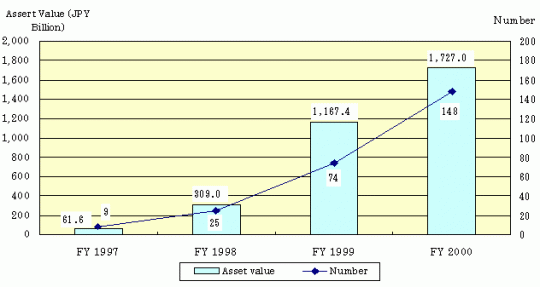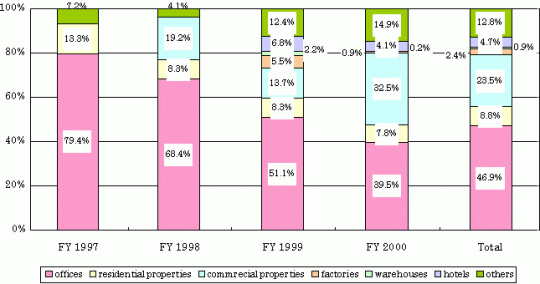The Liquidation of Real Property through Securitisation Methods: the current position
To meet the needs of originators discussed above in Section 2, the legal framework mainly developed is the “Asset Liquidation Scheme” and its use is advancing (see Chart 7).
In this section, the current status of the liquidation of real property through securitisation methods is discussed, based on the results of a survey into the “Current Status of Real Property Securitisation” (results of the research are from a survey of trust banks belonging to the Trust Companies Association of Japan conducted in March 2001, together with the results of the SPC Act and the Real Estate Syndication Business, conducted by the Ministry of Land, Infrastructure and Transport).
- The amount of properties and beneficial interest in trust liquidated from originators to Special Purpose Vehicles (SPVs)(Note1, Note2) amounted to JPY 3,300 billion4 (less than JPY 3,000 billion when liquidations in preparation of the establishment of Property Investment Funds are excluded) as of the end of March 2001. A rapid increase in the annual base trend is observed after the Fiscal Year 1998 (see Chart 8);
Note1: SPV (Special Purpose Vehicle): SPV is a corporation, trust or a partnership established for the special purpose of property liquidation, which entity agrees to be established for such a special purpose (including special purpose companies established based on SPC Act.)
Note2: Fund Raising for the SPV: Fund raising for the SPV is done by issuing securities and by borrowings from non-recourse loans. In this research, in order to attain the total volume of liquidated properties, raised funds were not limited to funds raised by issuing securities (in a narrow sense) but included funds by borrowings, etc (in broader sense).
Chart 7 History of Real Property Securitisation
| Laws and Ordinances | Project History | ||
|---|---|---|---|
| Mar-87 | Provision of the small lot trust type property products started | ||
| Apr-89 | Provision of the small lot partnership (Ninni Kumiai) type property products started | ||
| Dec-90 | Property conversion loans by the JRCC JRN Settlement Headquarters | ||
| April-95 | Enactment of the Real Estate Syndication Act | May-95 | Establishment of the first “lease type” product based on the Real Estate Syndication Act |
| Dec-95 | Establishment of the first “silent partnership (Tokumei-Kumiai) type” product based on the Real Estate Syndication Act | ||
| Dec-96 | Establishment of the first “partnership (Ninni-Kumiai) type” product based on the Real Estate Syndication Act | ||
| May-97 | Revisions of the Real Estate Syndication Act and regulations to the enforcement of the said Act - Minimum investment unit reduced from JPY100 million to JPY10 million, in principle - Deregulation of business to professional investors |
||
| Sep-98 | Enactment of the Law on Securitisation of Specified Assets by Special Purpose Companies | ||
| Nov-98 | Establishment of the first product based on the Law on Securitisation of Specified Assets by Special Purpose Companies | ||
| Feb-99 | Revision of regulations to the enforcement of the Real Estate Syndication Act - Minimum investment unit reduced from JPY 10 million to JPY 5 million - Removal of a ban on transferring to third parties |
||
| Sep-99 | Revision of Real Estate Syndication Act - newly introducing an agreement of modifying subject properties (type of replacement of properties) |
||
| Aug-00 | Introduction of accounting 5 percent rule Enforcement of off-balance standards by the Japanese Institute of Certificated Public Accountants |
||
| Sep-00 | Enactment of rules of registration of Property Investment Advisors | Oct-00 | First registration of Property Investment Advisors |
| Nov-00 | Revisions of the Law Concerning Investment Fund (Investment Trusts and Investment Corporations), the Building Lots and Building Transaction Business Law, etc. - Establishment of the Real Estate Investment Trust and Real Estate Investment Corporation (property investment funds) Revision of the Law on the Securitisation of Specified Assets by Special Purpose Companies (the Law Concerning Asset Liquidation) - Enlargement of coverage assets for securitisation, introduction of trust type scheme |
||
| Dec-00 | Starting of approval for agency by discretionary trust, based on the Building Lots and Buildings Transaction Business Law | ||
| Mar-01 | Tokyo Stock Exchange established a market for property investment funds | Mar-01 | Starting of approval for firms who are entrusted in relation to investment funds that invest to property investment and trust agent business subjecting property |
Source: prepared by Ministry of Land, Infrastructure and Transport based on “Real Property Securitisation Handbook” by the Council for Real Estate Syndication
Chart 8 Trends of Results of Liquidation of Real Property
|

Source: “Survey of Current Status of Real Property Securitisation” by Ministry of Land, Infrastructure and Transport
2.The following three uses represented nearly 80% of the total asset value of properties liquidated: offices (46.9%), commercial properties (23.5%) and residential properties (8.8%) (see Chart 9). However, in recent years, especially since the Fiscal Year of 1999, the types of property that have been liquidated have become more diverse. The liquidation of industrial properties, warehouses, hotels and other types of real property has increased. This trend is attributable to the fact that office and residential property for lease, where there is a separation between ownership and use, is generally held for investment purposes.
As a result, such property tends to be targeted for liquidation and is released in the early stages.
Properties which owners use for their own business activities such as industrial properties, warehouses and hotels, are, at present, generally liquidated by making use of the sales-and-leaseback scheme (Note3), which helps to enhance financial statements and ensure more effective corporate management, required in the current economic environment. Also it has become possible to reduce the risks associated with the liquidation of properties with relatively higher risk profiles (such as hotels) because of the accumulated experience and knowledge of liquidation. This could be one of the reasons why the types of liquidated properties have become more diverse;
Note3: Sales-and-Leaseback: Property sold, for liquidation, to an unrelated party and then rented back from the new owner by the original seller.
Chart 9 Proportion for Assets within Liquidated Real Property by Use of Properties

Source: same as Chart 8
Note: “others” includes properties that have multiple uses
3.The number of property liquidations using the sales-and-leaseback scheme has increased annually since the first case was developed in 1998, and it is observed that the number of liquidations of owner occupied properties has increased. In the Fiscal Year 2000, the sale-and-leaseback scheme was adopted for 40 properties, with a total value of around JPY 820 billion5 ;
4.The equity portions of SPVs owned by originators have been decreasing. This is due to changes in accounting standards, under which off-balance sheet accounting is no longer acceptable if originators own larger equity portions of SPVs. Pro forma liquidation schemes (in which most of the equity of SPVs continues to be owned by the originators), have also been disappearing, and actual liquidation schemes (i.e. where the originators are divested of their interests in the subject properties) represent the main approach to liquidating property;
5.As liquidations and experience have increased, liquidations have expanded from income-producing properties to also include properties under development. In the Fiscal Year 2000, over 20 cases of such under development liquidations were observed (among them, 14 condominium apartments and 3 commercial properties) with a total value of approximately JPY 100 billion6;
6.The achievements based on the SPC Act are as follows: During the two years and three months from the enactment of the Act in September 1998 and its amendment at the end of November 2000, a total value of approximately JPY 270 billion was achieved. Research covering trust banks shows transactions of more than JPY 150 billion over the four months after the amendment. It is assumed that this result reflects the realization of the effects of the amendment, such as the deregulation of the process of establishing special purpose companies, “Plan of Asset Securitisation” and the easing of bank lending for acquisition of specified assets;
7.We observe liquidations in connection with the establishment of Property Investment Funds, to meet the start-up of the “Asset Investment Scheme”, with assets of more than JPY 300 billion shown by the research covering trust banks; and
8.In relation to the investment basis for property liquidations, most funds were raised through non-recourse loans (Note4) and private placements to institutional investors. Participation by individuals through public offerings is limited because up to the present liquidation has been promoted in order to raise funds for originators, and fund providers are normally selected and confirmed prior to liquidation.
Originators tend to avoid public offerings, because of the time and costs involved.
5 US$ = JPY (Japanese Yen) 118 (as of 20 September 2001). JPY 820 billion =US$ 6.9 billion
6 US$ = JPY (Japanese Yen) 118 (as of 20 September 2001). JPY 100 billion = US$ 840 million
Note4: Non-Recourse Loans: The creditor’s recourse for the loan is limited to the amounts that can be realized from enforcing a security interest in the subject property.
